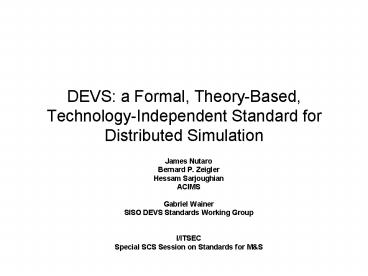DEVS: a Formal, Theory-Based, Technology-Independent Standard for Distributed Simulation
Title:
DEVS: a Formal, Theory-Based, Technology-Independent Standard for Distributed Simulation
Description:
DEVS: a Formal, Theory-Based, Technology-Independent Standard for Distributed Simulation James Nutaro Bernard P. Zeigler Hessam Sarjoughian ACIMS –
Number of Views:97
Avg rating:3.0/5.0
Title: DEVS: a Formal, Theory-Based, Technology-Independent Standard for Distributed Simulation
1
DEVS a Formal, Theory-Based, Technology-Independe
nt Standard for Distributed Simulation
- James Nutaro
- Bernard P. Zeigler
- Hessam Sarjoughian
- ACIMS
- Gabriel Wainer
- SISO DEVS Standards Working Group
- I/ITSEC
- Special SCS Session on Standards for MS
2
Modeling Simulation/Systems Theory
3
MS Framework
Objectives represented by
Layered architecture
Entities formalized as systems relations as
system morphisms
4
DEVS Modeling Simulation Framework
- DEVS Discrete Event System Specification
- Provides sound MS framework
- Derived from Mathematical dynamical system
theory - Supports hierarchical, modular composition and
reuse - Can express Discrete Time, Continuous and hybrid
models - Event-orientation enables efficient simulation
- Object-oriented, Distributed, Real-time
Implementations
5
DEVS Atomic Model
Make a transition (internal)
Make a transition (external)
input
State
internal
external
Send an output
time advance
Handle input
output
output
Hold for some time
Pulse Generator
time
interPulseTime gt0
Output
Pulse Generator
start
6
DEVS Hierarchical Modular Composition
- Atomic lowest level model, contains structural
dynamics -- model level modularity
Coupled composed of one or more atomic and/or
coupled models
hierarchical construction
coupling
7
Types of Models and their Formalisms
Coupled Models
Atomic Models
Partial Differential Equations
Ordinary Differential Equations
Processing/ Queuing/ Coordinating
Networks Collaborations
Physical Space
Phase Based Models
Pulse Based Models (varGen, Sum)
Digraph Models
1,2 Dim Cell Space
Discrete Time/ Automata
Quantum Based Models (DEVS Integrator, instantane
ous Functions
Cellular Automata
can be components in a coupled model
2 Dim State Space
1 Dim State Space
Self Organized Criticality Models
Multi Agent Systems
8
Scalability, Flexibility and Inter-operability
Through Interface Standardization
DEVS Simulation Protocol
Single processor
C
Java
Distributed Simulator
DEVS
Simulator
Other Representation
Real-Time Simulator
Non DEVS
9
For more literature, software, tutorials,
- Arizona Center for Integrative
- Modeling Simulation
- (ACIMS)
- www.acims.arizona.edu































